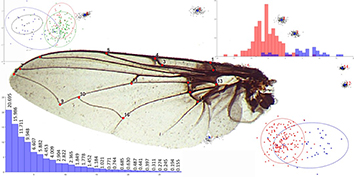Volume 8, Issue 3 (2022)
J. Insect Biodivers. Syst 2022, 8(3): 449-465 |
Back to browse issues page
Download citation:
BibTeX | RIS | EndNote | Medlars | ProCite | Reference Manager | RefWorks
Send citation to:



BibTeX | RIS | EndNote | Medlars | ProCite | Reference Manager | RefWorks
Send citation to:
Badu I, Combey R, Quandahor P. Assessment of variation between two blowfly species, Lucilia cuprina (Wiedemann) and Lucilia sericata (Meigen) (Diptera, Calliphoridae) using geometric morphometrics and cuticular hydrocarbon profiling. J. Insect Biodivers. Syst 2022; 8 (3) :449-465
URL: http://jibs.modares.ac.ir/article-36-60503-en.html
URL: http://jibs.modares.ac.ir/article-36-60503-en.html
1- Department of Conservation Biology and Entomology, School of Biological Sciences, College of Agriculture and Natural Sciences, University of Cape Coast, Ghana. , isaakbadu@gmail.com
2- Department of Conservation Biology and Entomology, School of Biological Sciences, College of Agriculture and Natural Sciences, University of Cape Coast, Ghana.
3- CSIR-Savanna Agricultural Research Institute, P.O.Box 52, Tamale, Ghana.
2- Department of Conservation Biology and Entomology, School of Biological Sciences, College of Agriculture and Natural Sciences, University of Cape Coast, Ghana.
3- CSIR-Savanna Agricultural Research Institute, P.O.Box 52, Tamale, Ghana.
Abstract: (1306 Views)
View on Scopus
Lucilia cuprina and Lucilia sericata are two closely related species due to their similarity in morphology, habitat, distribution, and economic importance. Even though other methods have segregated the species, the aspect of comparative studies on geometric morphometrics and cuticular hydrocarbon composition in species variability is yet to be explored in these species. This study was conducted to assess variability between the two species and between the sexes. Wing shapes of 187 specimens of both species were analysed by geometric morphometric techniques. Landmarks 11, 10, 6 and 9, which corresponds to the intersection between the medial and the radial medial veins, medial and branched cubitus veins, distal end of radius vein (R2 + 3 vein) and curve point of medial vein, respectively, contributed significantly to the variability within and between species. Cuticular hydrocarbon profiles of four randomly collected individuals each of male and female L. cuprina and L. sericata, were assessed using GC-MS. Octadecene, Celidoniol, Hexatriacontane, Tetracontane and Tetracontane were identified as common for both species. 9-Octadecenal(z) and Tetracosane-11-decyl being recorded as the most abundant hydrocarbons in male and female L. cuprina, and 13-methylheptacosane and Tetratetracontane in male and female L. sericata, respectively. Diagnostic characters indicating the variabilities can be used for the identification of the species.
Lucilia cuprina and Lucilia sericata are two closely related species due to their similarity in morphology, habitat, distribution, and economic importance. Even though other methods have segregated the species, the aspect of comparative studies on geometric morphometrics and cuticular hydrocarbon composition in species variability is yet to be explored in these species. This study was conducted to assess variability between the two species and between the sexes. Wing shapes of 187 specimens of both species were analysed by geometric morphometric techniques. Landmarks 11, 10, 6 and 9, which corresponds to the intersection between the medial and the radial medial veins, medial and branched cubitus veins, distal end of radius vein (R2 + 3 vein) and curve point of medial vein, respectively, contributed significantly to the variability within and between species. Cuticular hydrocarbon profiles of four randomly collected individuals each of male and female L. cuprina and L. sericata, were assessed using GC-MS. Octadecene, Celidoniol, Hexatriacontane, Tetracontane and Tetracontane were identified as common for both species. 9-Octadecenal(z) and Tetracosane-11-decyl being recorded as the most abundant hydrocarbons in male and female L. cuprina, and 13-methylheptacosane and Tetratetracontane in male and female L. sericata, respectively. Diagnostic characters indicating the variabilities can be used for the identification of the species.
Article Type: Research Article |
Subject:
Systematics/Diptera
Received: 2022/03/31 | Accepted: 2022/07/1 | Published: 2022/08/13
Received: 2022/03/31 | Accepted: 2022/07/1 | Published: 2022/08/13
References
1. Aubertin, D. (1933) Revision of the genus Lucilia RD (Diptera, Calliphoridae). Journal of the Linnean Society: Zoology, 38 (260), 389-436. [DOI:10.1111/j.1096-3642.1933.tb00991.x]
2. Barbosa, R.R., Braga, M.V., Blomquist, G.J. & Queiroz, M.M. de C. (2017) Cuticular hydrocarbon profiles as a chemotaxonomic tool for three blowfly species (Diptera: Calliphoridae) of forensic interest. Journal of Natural History, 51 (25-26), 1491-1498. [DOI:10.1080/00222933.2017.1337944]
3. Barretto, D.A. & Vootla, S.K. (2018) Gc-Ms Analysis of bioactive compounds and antimicrobial activity of Cryptococcus rajasthanensis Ky627764 isolated from Bombyx mori gut microflora. International Journal of Advanced Research, 6 (3), 525-538.
https://doi.org/10.21474/IJAR01/6700 [DOI:10.21474/ijar01/6700]
4. Blomquist, G.J. (2010) Structure and analysis of insect hydrocarbons. In: Blomquist, G. J. & Bagnères, A.G. (eds.) Insect Hydrocarbons: Biology, Biochemistry and Chemical Ecology. Cambridge University Press, Cambridge, pp. 19-34. [DOI:10.1017/CBO9780511711909.003]
5. Blomquist, G.J., Tillman-Wall, Guo, L., Quilici, D.R. & Schal, C. (1993) Hydrocarbon and Hydrocarbon derived sex pheromones in insects: biochemistry and endocrine regulation. In: Stanley-Samuelson, D.W., Nelson, D.R. (eds.) Insect Lipids: Chemistry and Biology. University of Nebraska Press. Lincoln, pp. 317-351.
6. Combey, R., Tsifoanya, M.T., Kwafo, R., Kofi, E. & Tuadzra, A. (2017) Necrophagous insects succession on carrions' of two tropical animals. European Journal of Zoological Research, 5 (2), 1-9.
7. Concha, C. & Scott, M.J. (2009) Sexual development in Lucilia cuprina (Diptera, Calliphoridae) is controlled by the transformer gene. Genetics, 182 (3), 785-798. [DOI:10.1534/genetics.109.100982]
8. Dag, A. & Gazit, S. (2000) Mango pollinators in Israel. Journal of Applied Horticulture, 2 (1), 39-43. [DOI:10.37855/jah.2000.v02i01.12]
9. David, W.A.L. (1967) The physiology of the insect integument in relation to the invasion of pathogens. In: Beament, J.W.L. & Treherne, J.E. (eds.) Insects and Physiology. Oliver and Boyd, London, UK, pp. 17-35.
10. Derstine, N.T., Gries, R., Zhai, H., Jimenez, S.I. & Gries, G. (2018) Cuticular hydrocarbons determine sex, caste, and nest membership in each of four species of yellowjackets (Hymenoptera: Vespidae). Insectes Sociaux, 65 (4), 581-591. [DOI:10.1007/s00040-018-0649-0]
11. Du Plessis, H.J.C. & Pretorious, J.P. (2011) The utilisation of maggot debridement therapy in Pretoria, South Africa: wound care. Wound Healing Southern Africa, 4 (2), 80-83.
12. Espra, S., Tabugo, S.R.M., Torres, M.A.J., Gorospe, J.G., Manting, M.E. & Demayo, C.G. (2015) Describing dimorphism in wing shapes in the blowfly Lucilia sericata Meigen (Diptera: Calliphoridae) using geometric morphometrics. Advances in Environmental Biology, 9 (19), 64-70.
13. Heath, A.C.G. & Bishop, D.M. (2006) Flystrike in New Zealand : An overview based on a 16-year study , following the introduction and dispersal of the Australian sheep blowfly, Lucilia cuprina Wiedemann (Diptera : Calliphoridae). Veterinary Parasitology, 137, 333-344. [DOI:10.1016/j.vetpar.2006.01.006]
14. Hepburn, G.A. (1943) Sheep blowfly research I. - A survey of maggot collections from live sheep and a note on the trapping of blowflies. Onderstepoort Journal of Veterinary Science and Animal Industry, 18 (1-2), 13-18.
15. Holloway, B.A. (1991) Morphological characters to identify adult Lucilia sericata (Meigen, 1830 ) and Lucilia cuprina (Wiedemann, 1830) (Diptera: Calliphoridae). New Zealand Journal of Zoology, 18 (4), 413-420.b [DOI:10.1080/03014223.1991.10422847]
16. Jimenez-Martin, F.J., Cabrero, F.J. & Martínez-Sanchez, A. (2020) Wing morphometrics for identification of forensically important blowflies (Diptera : Calliphoridae) in Iberian Peninsula. Journal of Forensic and Legal Medicine, 102048, 1-10. [DOI:10.1016/j.jflm.2020.102048]
17. Khidr, S.K., Linforth, R.S.T. & Hardy, I.C.W. (2013) Genetic and environmental influences on the cuticular hydrocarbon profiles of Goniozus wasps. Entomologia Experimentalis et Applicata, 147 (2), 175-185. [DOI:10.1111/eea.12058]
18. Klingenberg, C.P. (2011) MorphoJ: an integrated software package for geometric morphometrics. Molecular Ecology Resources, 11, 353-357.
https://doi.org/10.1111/j.1755-0998.2010.02924.x [DOI:doi: 10.1111/j.1755-0998.2010.02924.x]
19. Koidsumi, K. (1957) Antifungal action of cuticular lipids in insects. Journal of Insect Physiology, 1(1), 40-51. [DOI:10.1016/0022-1910(57)90022-7]
20. Lutz, L., Williams, K.A., Villet, M.H. & Ekanem, M. (2018) Species identification of adult African blowflies (Diptera : Calliphoridae) of forensic importance. International Journal of Legal Medicine, 132, 831-842. [DOI:10.1007/s00414-017-1654-y]
21. Macedo, M.P., Arantes, L.C. & Tidon, R. (2018) Sexual size dimorphism in three species of forensically important blowflies (Diptera: Calliphoridae) and its implications for postmortem interval estimation. Forensic Science International. [DOI:10.1016/j.forsciint.2018.10.009]
22. Moore, H.E., Adam, C.D. & Drijfhout, F.P. (2014) Identifying 1st instar larvae for three forensically important blowfly species using "fingerprint" cuticular hydrocarbon analysis. Forensic Science International, 240, 48-53. [DOI:10.1016/j.forsciint.2014.04.002]
23. Moore, H.E., Pechal, J.L., Benbow, M.E. & Drijfhout, F.P. (2017) The potential use of cuticular hydrocarbons and multivariate analysis to age empty puparial cases of Calliphora vicina and Lucilia sericata. Scientific Reports, 7 (1), 1-11. [DOI:10.1038/s41598-017-01667-7]
24. Nuñez-rodríguez, J.A. & Liria, J. (2017) Geometric morphometrics sexual dimorphism in three forensically- important species of blow fly (Diptera : Calliphoridae). Life: The Excitement of Biology, 4 (4), 272-284.
25. Peterson, M.A., Dobler, S., Larson, E.L., Juárez, D., Schlarbaum, T., Monsen, K.J. & Francke, W. (2007) Profiles of cuticular hydrocarbons mediate male mate choice and sexual isolation between hybridising Chrysochus (Coleoptera: Chrysomelidae). Chemoecology, 96, 87-96. [DOI:10.1007/s00049-007-0366-z]
26. Rose, H. & Wall, R. (2011) Modelling the impact of climate change on spatial patterns of disease risk: Sheep blowfly strike by Lucilia sericata in Great Britain. International Journal for Parasitology, 41 (7), 739-746. [DOI:10.1016/j.ijpara.2011.01.012]
27. Sappington, T.W. & Taylor, O.R. (1990) Disruptive sexual selection in Colias eurytheme butterflies. Proceedings of the National Academy of Sciences, 87 (16), 6132-6135. [DOI:10.1073/pnas.87.16.6132]
28. Sharanya, B. & Zuha, R.M. (2019) A preliminary geometric morphometrics assessment of two forensically important blowfly larvae in Malaysia, Chrysomya megacephala (Fabricus) and Chrysomya rufifacies (Macquart) (Diptera: Calliphoridae). Serrangga, 24 (1), 70-79.
29. Vogt, W.G. & Woodburn, T.L. (1979) Ecology, distribution and importance of sheep myiasis flies in Australia. National Symposium on the Sheep Blowfly and Flystrike in Sheep, Sydney, NSW (Australia), 25 Jun 1979. Department of Agriculture, New South Wales, 30-32.
30. Williams, K.A., Cronje, F.J., Avenant, L. & Villet, M.H. (2008) Identifying flies used for maggot debridement therapy. Scientific Letters, 98 (3), 4-5.
31. Williams, K.A. & Villet, M.H. (2014) Morphological identification of Lucilia sericata, Lucilia cuprina and their hybrids (Diptera, Calliphoridae). Zookeys, 420, 69-85. [DOI:10.3897/zookeys.420.7645]
Send email to the article author
| Rights and permissions | |
 |
This work is licensed under a Creative Commons Attribution-NonCommercial 4.0 International License. |










